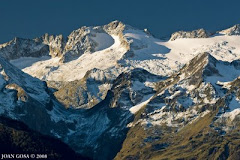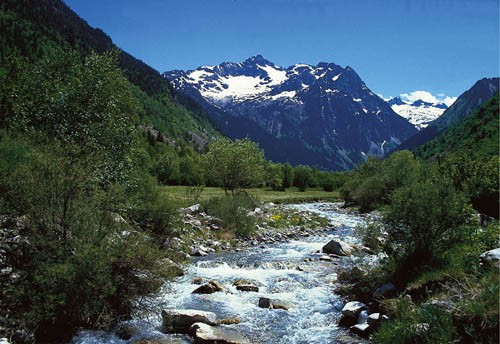
A important sport in the Aran Vall is the rafting. An other important sport is the climbing because there are a big and high mountains.
In this place the most important sports are the risk: rafting, climbing, callac, parachuting…
Climbing is the activity of using one's hands and feet (or indeed any other part of the body) to ascend a steep object. It is done both for recreation (to reach an inaccessible place, or for its own enjoyment) and professionally, as part of activities such as maintenance of a structure, or military operations.
Climbing activities include:
Ice climbing: Ascending ice or hard snow formations using special equipment designed for the purpose, usually ice axes and crampons. Protective equipment is similar to rock climbing, although protective devices are different.
Mountain climbing: Ascending mountains for sport or recreation. It often involves rock and/or ice climbing.
Rock climbing: Ascending rock formations, often using climbing shoes and a chalk bag. Equipment such as ropes, bolts, nuts, hexes and camming devices are normally employed, either as a safeguard or for artificial aid.
Tree climbing: Ascending trees without the intention of harming them, using ropes and other equipment. This is a less competitive activity than rock climbing.
Skiing
Skiing is a group of sports using skis as equipment for traveling over snow. Skis are used in conjunction with boots that connect to the ski with use of a binding.
Early history
A Sami skier as seen by Olaus MagnusPre-historic Nordic people and Samis invented skiing to assist hunting, military maneuvers, and as a practical transportation for themselves. The oldest and most accurately documented evidence of skiing origins is found in modern day Norway and Sweden. The earliest primitive carvings circa 5000 B.C. depict a skier with one pole, located in Rødøy in the Nordland region of Norway. Joel Berglund reported in 2004 the discovery of a primitive ski, or "85cm long piece of wood", carbon tested by researchers in 1997 while excavating a Norse settlement near Nanortalik, Greenland. The primitive ski dated back to 1010, and is thought to be Greenland's oldest ski brought by Norsemen circa 980 A.D
Alpine skiing
Alpine skiing is also called downhill skiing. Typically downhill skiing takes place at a ski resort with specified ski pistes or ski runs. Ski resorts that offer downhill skiing exist all over the world in cold climate areas. Non-competitive alpine skiing is recreational skiing. Also in the category of Alpine skiing are the Alpine competitions known as slalom, giant-slalom, and down-hill. Recently a new category, called super-giant-slalom.
Freestyle skiing
Aerial freestyleAlpine Freestyle: This kind of skiing employs the use of aerial acrobatics and balance, balance being necessary for rails.Freestyle/Newschool: Freestyle skiing is the type of skiing with which tricks are usually associated. The skis used are generally of a twin tip design, made to land switch tricks (backwards) as easily as forwards. Tricks are generally spins and flips, that can be conjoined with a grabbing of the ski to improve the image of the trick. Freestyle skiing generally takes place in terrain parks at ski resorts, with a wide variety of jumps, rails, jibs and other features to session. Mogul skiing is also considered as freestyle skiing.
Nordic skiing
Nordic skiing may be the most popular form of skiing since it does not require a specialty ski area.
Military skiing
Military Skiing: In addition to its role in recreation and sport, skiing is also used as a means of transport by the military, and many armies train troops for ski warfare.
Skiing competition
Skiing competition is organized by the International Ski Federation, which is responsible for development of rules and scheduling of competitions worldwide in alpine skiing, cross country skiing, freestyle skiing.
Stations in Aran Val
http://baqueira.costasur.com/en/index.html








